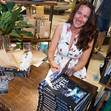Zena Shapter's Blog, page 6
August 15, 2022
2022 #CreativeOpen @HarryHartogBookseller @beachescouncil
It’s been a busy few weeks preparing for the 2022 Creative Open, for the fabulous Local Author Table and Publishing/Writing Q&A Booth I organised to support local writers and writing on Sydney’s Northern Beaches. I even did a little video to get readers and writers interested – what do you think?
After these past few pandemic-obscured years, it was so much fun talking to book-buying readers and writers about stories on Saturday! It really makes a difference, knowing how your creativity and hard work is appreciated.
My sincere thanks to Harry Hartog Booksellers at Warringah Mall for hosting and presenting such an amazing display of all our books, for putting them into their system, and offering to keep any leftover books on the shelves for future sales. All the authors took turns behind the exhibition table, cross-promoting each other, which was easy since, collectively, we had something to offer everyone! Well, almost…
 ‘Towards White‘ by me – mystery, thriller, science fiction, romance, Iceland.‘Into Tordon‘ co-authored by me – middle grade (8-12yrs), gaming, adventure, science fantasy, Australia.‘The Fatalist’ by Campbell McConachie – true crime, journalism, Sydney. ‘Joe’ by Guy Hallowes – people smuggling, wealth management, corruption, Africa, London. ‘Icefall’ by Guy Hallowes – climate change, ice caps, thriller, worldwide.‘The Heritage You Leave Behind’ by Susan Steggall – historical fiction, mystery, art, Scotland, Australia.‘Tis the Doing Not the Deed’ by Susan Steggall – historical & contemporary fiction, mystery, art fraud, France, Australia.‘See You at Randell’s’ by Jenny Brosnan & Anne Stephenson – local history, ballroom dancing, Sydney 1940s-80s.‘How to Disappear’ by Bruna Gomes – YA, contemporary, murder mystery, Sydney, worldwide.‘Triple Citizenship’ by Bruna Gomes – poetry collection, identity, multiculturalism.‘Where Your Happiness Hides’ by Mark Worthington – self-improvement, happiness, society.
‘Towards White‘ by me – mystery, thriller, science fiction, romance, Iceland.‘Into Tordon‘ co-authored by me – middle grade (8-12yrs), gaming, adventure, science fantasy, Australia.‘The Fatalist’ by Campbell McConachie – true crime, journalism, Sydney. ‘Joe’ by Guy Hallowes – people smuggling, wealth management, corruption, Africa, London. ‘Icefall’ by Guy Hallowes – climate change, ice caps, thriller, worldwide.‘The Heritage You Leave Behind’ by Susan Steggall – historical fiction, mystery, art, Scotland, Australia.‘Tis the Doing Not the Deed’ by Susan Steggall – historical & contemporary fiction, mystery, art fraud, France, Australia.‘See You at Randell’s’ by Jenny Brosnan & Anne Stephenson – local history, ballroom dancing, Sydney 1940s-80s.‘How to Disappear’ by Bruna Gomes – YA, contemporary, murder mystery, Sydney, worldwide.‘Triple Citizenship’ by Bruna Gomes – poetry collection, identity, multiculturalism.‘Where Your Happiness Hides’ by Mark Worthington – self-improvement, happiness, society.Thank you to all the wonderful authors who supported my vision and joined in the fun. Thank you to Northern Beaches Council for championing the idea. No one actually came into the bookshop because they knew the Creative Open involved our events or that the Creative Open was even happening, but having the council involved gave us legitimacy – when we mentioned it, readers took a step closer to the table, and anything that brings readers closer to buying a book is appreciated!
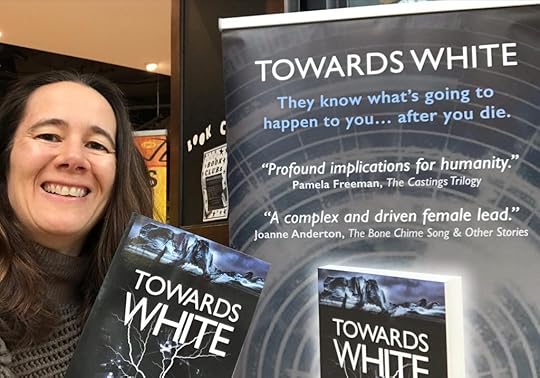
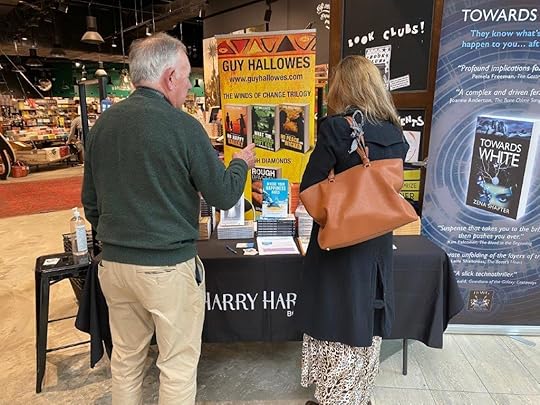 Guy Hallowes closing a sale
Guy Hallowes closing a sale
 YA author & poem, Bruna Gomes
YA author & poem, Bruna Gomes
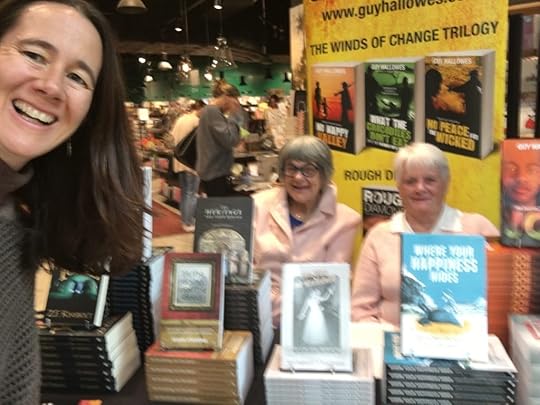 Ballroom Dancing Legends, Anne Stephenson & Jenny Brosnan
Ballroom Dancing Legends, Anne Stephenson & Jenny Brosnan
 Susan Steggall & me
Susan Steggall & meMore book news to follow soon hopefully, something I’ve been sitting on for a while!!
June 27, 2022
Modern Creative Writing – Resist or Evolve?
Did you know that in the 18th century, stories could only be printed and published in England if they were true? Powerful religious influences at the time otherwise deemed stories as ‘lies’ and thus ‘evil’. You can see the effect of this in the book titles published at the time, and how they suggest the story belongs to a real person, whose experiences actually happened, such as:
‘Robinson Crusoe’ by Daniel Defoe (1719)‘Gulliver’s Travels’ by Jonathan Swift (1726)‘Pamela: Or, Virtue Rewarded’ by Samuel Richardson (1740)‘Joseph Andrews/Shamela’ by Henry Fielding (1742)‘The History of Tom Jones, a Foundling’ by Henry Fielding (1749)‘Cecilia’ by Fanny Burney (1782)‘Camilla’ by Fanny Burney (1796)‘The Life and Opinions of Tristram Shandy, Gentleman’ by Laurence Sterne (1759)The value of fictional stories told as ‘novels’ was in flux, and wouldn’t be defined until the 19th century. Thus the irony was that writers had to claim their story was true in order to avoid being called a liar!
We’ve come a long way since then. We’ve experienced developmental eras such as Romanticism and Modernism, we’ve experimented with style such as Stream of Consciousness and Gothic, we’ve even created new genre such as Young Adult and Climate Fiction.
Since the rise of television and movies, and now social media, we’ve also become a very visual culture. We want to be shown, not told about characters, so we can imagine and deduce our own conclusions about them. Gone are long passages at the start of stories, telling of a particular character or place. We want to infer a character through their actions and decide for ourselves whether what they are doing is interesting enough to read on.

There are many techniques writers can use to make their creative writing ‘modern’ in this way, such as focusing more on action, dialogue, and internal thought to tell a story, rather than detailed descriptions and summarising. There’s some free advice for writers on my Writing Rockface post ‘The Over Blight’, such as how to identify when certain writing devices don’t belong in a narrative at a given point, which can risk over-telling, over-showing, over-writing, over-explaining or over-poeticising.
Still, all evolution commonly encounters resistance because it’s natural to value the status quo, and I often see this when mentoring or editing clients who reference ‘the classics’ in order to justify their creative writing decisions.

Classics are classics for their resonance of ideas and themes, for their cultural importance or groundbreaking contributions, for the way they offer deep explorations into what it means to be human. At the same time, since storytelling tastes constantly change as our lives also change, creative writing decisions must also change. Thus many older classics can be both highly valued and written with too much detail and wordiness by today’s standards.
I love how language evolves over time (see my posts ‘I Fear Me The Worm, How The Meanings Of Words Change‘, ‘Words Reveal Who We Really Are‘ and ‘The Throwaway Culture of Forbidden Words‘). Much to my teenagers’ distress, my favourite trendy words right now are ‘mid‘ and ‘OG‘.
Laying out a book in InDesign recently for a publisher, I had to create multiple template boxes to resemble text messages – they are such an important element of modern life, the book layout demanded a replication of reality.

But who knows if any trend will stay or go, and who knows how creative writing will continue to evolve. All we can be certain of is that it will, and writers can either resist that or evolve with it.
June 13, 2022
‘So… Why Is That There?’ #Storytelling
Of all the questions I ask my creative writing clients and students when mentoring and editing, this is the question I ask them the most.
It generally has two manifestations, which I thought I’d share as insight into the storytelling process.
1. Studying Other WritersWhen reading and studying other writers, I’ll often point out a writing technique being used and ask my client/student why the writer put it there. My aim is to give them an opportunity to devise the resulting affect, appreciate the thought that went into creating it, then see how they might apply that to their own stories. However, it’s rarely that easy:
“So why do you think they put that there?” I’ll ask them.
“I don’t know…” They often pause to think. “To be interesting?”
“Hm, not quite. Can you guess again?”
“Um, to make the writing more interesting.”
At which point I’ll identity a more specific effect or two, along with the knock-on effect on the rest of the story, and my client/student will quickly develop their appreciation. Sometimes, however, I’ll also go on to explain the real-life creative writing process to them, and I’m always surprised when they don’t realise the effort involved, or the length of the journey to publication.
The creative writing process often looks a little like this:
WriterWrite first draftRethinkWrite second draftRethinkWrite third draftPut draft aside for a whileWrite fourth draftInitial ReadersSend out to first reader(s)Write fifth draftSend out to beta reader(s)Write sixth draftEditor + ProofreaderStructural editWrite seventh draftCopy editWrite eighth draftProofreadWrite ninth draftLayoutSend to layoutCheck layoutSent to printFor this reason, writers rarely do anything just to be ‘interesting’. Every sentence has to be considered and rethought, every paragraph, every scene, and certainly every technique. This is why studying others’ creative writing and being aware of the creative process can be useful – it’s not just a writer communicating ‘something interesting’ to you, it’s an entire team of people telling you a story.
2. Assessing Own WorkWhen reading and assessing my client’s or student’s own creative work, I’ll often point to sentence, paragraph or scene, and ask them why they put it there. My hope is that they’ll be able to justify their creative decision, and perhaps reflect on the consequences for the story. However, it’s rarely that easy:
“So why did you put that there?” I’ll ask them.
“Because…” They often pause to think. “That’s what happens next.”
“Hm, but does it move the ‘story’ itself along, show your character or their world developing, or offer the reader a fitting moment of introspection?”
“Um, maybe not.”
At which point I’ll give them some advice a literary agent once told me: ‘use it or lose it’ (thanks Cameron McClure!). Every word in a story has to work for its place on the page. If it’s not doing a job, it’s probably unnecessary and should be cut.

It can be hard to do this as a writer, as we tend to like words! There’s nothing like weaving a wondrous whorl of words to whirl your reader with delicious enchantment. I call this our ‘secret poet’. But there is something more important to a writer than words – and that’s story.
Writers can become attached to words, we can even be proud of them; but as Sir Arthur Quiller-Couch wrote in his 1916 book ‘On the Art of Writing’, later reiterated by Stephen King in his book ‘On Writing’, we must sometimes ‘murder our darlings’ for the sake of our story.
Story must come first, because that’s what we’re trying to communicate to the reader. We’re trying to create an emotional connection, offer readers a deeper understanding of human experiences, show them how to make sense of others and ourselves. Stories can inspire us or warn us about what to do and who to be. Stories can create empathy, fear, hope or laughter. Stories are the best invention ever created!!
So, if I have to cut a sentence, paragraph, scene or chapter to make my story better – I’m in. I create a document called ‘Rejects’ and I copy and paste my deletions into it, because the creator in me hopes I might re-use them one day, either in a future draft of the same work, or in a new work.
As you can imagine, I have many ‘Reject’ documents on my computer, all with fabulous words waiting to be re-used – although, to date, I don’t think I ever have.
May 30, 2022
What’s in a Name?

This month, editor extraordinaire of Women’s Ink Magazine Jacqui Brown invited five authors – including me! – to talk about how we name our characters. Kristin Darell, who co-authored Into Tordon with me, was also featured; as was Valerie Pybus, Anne Benjamin and Australia’s climate fiction queen Cat Sparks.
Our answers were as various as the genres in which we all write, but the one process we had in common was: research. Whether it’s a top 100 name list for a time or place, websites offering explanations of names, an encyclopaedia, or checking a name’s cultural authenticity, we all put considerable effort and thought into our characters’ names.
For me, one of the most important things is to make sure readers don’t get confused between characters’ names. For this reason, I make an alphabetised list of names I use in each story, to help ensure no two names sound alike or start with the same letter.
Personal association helps too. As I was telling a client during a mentoring session only yesterday, giving characters names that have memories attached to them can help portray them with feeling. It could be a memory of an actual person you know, or a collective memory of a famous person with distinct mannerisms and a certain way of speaking – either way, if they match the personality of the character you’re trying to portray, use their name! At least while drafting the story – you can change anything before publication of course.
I also keep a list of ‘Names To Use’, to which I add names I like the sound of – be that from real life, watching the news, or reading TV and film credits. Sometimes I’ll include a common noun that should be a name. Sometimes I’ll make up a name. But having a list on hand gives me a good starting point for characters.
Checking the root of a name is also a good idea, and I do this with placenames too. From where did the name originate? If I’m creating a fictional world, then the names of the places and people could suggest a certain location, and I may or may not want that.
Finally, I also do a quick search to see if anyone already exists with the same name, either fictionally or in reality. The results could have me swiftly selecting a new name! Perhaps the name is more popular than I thought and my character needs something more unique. Perhaps there are public associations with the name that I’d rather avoid.
There are other aspects to consider too. A character’s name has to suit the genre of your story, making sense with its context and themes. It has to be consistent for readers, which usually means referring to a character by a single name and not switching between variants of that name. Character names need to be easy to pronounce, even in writing, since readers hear their names in their minds. If there are literary devices at play – such as symbolism, onomatopoeia or alliteration – you have to consider the affect of those devices. Might a character be given a nickname and, if so, what? If a character has a first and last name, those names need to sound good together – eg Callum Murray…
There’s some fun to be had with names too – not only are there ‘‘; but the Urban Dictionary offers humorous definitions for names. The definition of ‘Zena’ is very complimentary, will yours be too?

He he… Try it with your own name!
April 28, 2022
Northern Beaches Writers’ Competition – Judges’ Report #ArtandWordsProject 2022
 Image: ‘Magical Tree’ by Liliarta Visions
Image: ‘Magical Tree’ by Liliarta VisionsWow, what an exciting month it’s been reading all the entries for the inaugural Northern Beaches Writers’ Competition!
As the 2022 Northern Beaches ‘Art & Words Project’, the competition invited writers to submit both a written entry of up to 2,500 words on the theme of ‘tree’, and an image that reflected and enhanced that entry. Tree – tree of life, family tree, trees, tree network, tree diagram, decision tree – entries could be non-fiction, fiction, or fiction inspired by true events, all genres and styles were welcome, and the writers of Australia did not disappoint!
I read stories about bushfires, bushwalks, tree houses, tree escapes, dryads, fairies, horticulturalists, mythical trees, enchanted trees, symbolic trees, cultural trees, and even a future without trees. There were environmental tales, trees with significance to family and relationships, stories about the Covid-19 pandemic, cancer and grief. The trees themselves varied – cherry trees, Christmas trees, coconut, fig, flame, gum, ironbark, jacaranda, mandarin, mulberry, palm, pepper, sequoia, and more. There were insightful non-fiction accounts of trees, stories told from the perspective of trees, as well as engaging settings beside lakes, swimming pools, Scotland Island, Jindabyne, rural Australia, and… a cemetery!
Since the competition was supported by both myself and the Northern Beaches Writers’ Group, each and every story was read by a total of seven judges, reading completely blind – so for any entry to even make it onto the shortlist was a huge achievement. The creative standard was also extremely high, with entries from all over New South Wales, Queensland, Western Australia, South Australia, Victoria, the Australian Capital Territory, and Tasmania. I’m so very proud of the results.
Congratulations to everyone who entered, and of course the winners!
1st Place‘Flame Tree’ by Lisa Cortez, SA
2nd Place (Joint Winners)‘Agonis Flexuosa’ by Rosanne Dingli, WA
‘The Blood Tree’ by Jennifer Nash, NSW
‘It Won’t Come When You Call It’ by Caroline Sully, NSW
I would also like to take this opportunity to thank my ever-patient husband and children for their continual encouragement of and interest in my endeavours advocating for inclusive creativity opportunities in my community. This competition took about 55 hours to arrange and judge, and I acknowledge and appreciate your support of that.

Thank you also to the amazing judges who joined me in this quest, for your time, reliability and impressive dedication!
Azmeena KellyBronwen BowmanKate GallowayPhil BurginRose SaltmanTara RayPlease now click through to the competition results page to read the winning entries, as well as more about these fabulous judges.
Thank you, everyone!
March 22, 2022
#WomensHistoryMonth Work-Life Balance @GillianPolack
It’s ‘Women’s History Month’! So the gracious Gillian Polack invited me to consider how we’re living through ‘epoch-changing times’ in which ‘all of us are making history’, and I put my mind to thinking how the experiences of the last few years have affected my work-life balance. The results of my contemplation are now up on Gillian’s Blog!
Here’s the opening:

“About 80% of my working week I spend alone. I love it! I fully embrace the seclusion of my creative space to write, edit, create books, develop workshops, and run my creative support business. I interact with the world face-to-face to mentor, teach and give talks; then slink back into the silent hours that once more have me spinning webs of conception and narrative construction, for myself or others.
Outside of that working week, I relish a different type of time: louder, busier, full of ever-debating teenagers, a boisterous husband, exercising, home-maintenance and organising. Weekends bring precious moments with friends, getting outdoors in nature, DIY, groceries, writing meetups or events, and visual storytelling via a flat black noisy screen that we all huddle around at night. Different hours to savour and appreciate.
It sounds like a balanced lifestyle. Both loud and quiet. I love my life!
Yet there’s one thing missing…”
Read the rest of that article – and discover one way we might cope with the frantic and the loud that is the new normal – over here.
February 21, 2022
Movies & Potatoes
Every so often, I review my website. I refine or simplify pages, information and/or portfolio items; I look at what can be deleted and at what’s missing. In a review I conducted last month, I was horrified to see I had failed to include biographical information about two of my most beloved things in life: movies and potatoes!

No more!
I have now corrected this terrifying blunder, and would like to present to you the following:
MoviesA page dedicated to my love of movies. What’s your favourite movie of all time?
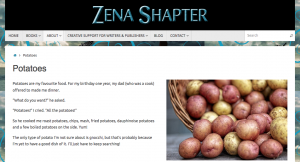 Potatoes
PotatoesA page dedicated to my love of potatoes. What is your favourite way of eating potatoes?
These pages join other highly informative pages already in my ‘About’ collection of things I like and dislike, including:
ChocolateFrogsAntsDrivingIf you were to make a list of the top things you like and dislike, what would it include?
February 8, 2022
Why I Love Libraries #LibraryLoversDay

‘Library Lovers Day’ is next week, and so the good people at Australia Reads (where I am honoured to be an ambassador), sent me a text meme to celebrate. It made me think: why do I love libraries?
A deluge of memories flooded into a list of 18 reasons I thought I’d share!
1. MagicWhen I was little, my mum often took me to our local library. I loved reading and libraries had books. As long as a book was age-appropriate, the librarians let me take it home. How miraculous!
2. SanctuaryWhen I was at school and had trouble with friends, the school library was a calm and serene place that welcomed readers. I could go there whenever I liked and it wouldn’t judge me. I’d even get a headstart on classwork, or homework, and there were books that could help with that. Amazing!
3. WeatherWhen I was at high school, I volunteered in the school library and, when it rained, the librarians let me read in there. In wet weather we were supposed to go to our classrooms, but everyone else was in there. Generous!
 4. Study
4. StudyWhen I needed a book that wasn’t available in my local library, the librarians would phone another branch in the district, reserve their copy for me, then have it transferred. One time I couldn’t wait for the transfer, so my mum drove me for an hour to the branch, an hour home again. Emergency help!
5. InclusiveWhen I was at university, the campus library kept reference copies of all the most important books. It also had cheap photocopying machines. So if I couldn’t afford to buy a book, and the library loan copies were all out, I could use the reference book to photocopy the pages I needed. Useful!
6. QuestionsWhen I went to another university and didn’t know anyone, the department library was a great place to ask for help. If someone was studying the same book as me, in the library at the same time, chances are they were part of my tribe. I could ask them a question, or they could ask me, and we’d learn together. Connection!
7. QuietWhen I was a mum of two, under two, it could be loud and hectic at home – so every Saturday I could, I’d escape to my local library to write or catch up on work. There was good Wi-Fi and a plethora of regulars who went to read newspapers or use the internet. They’d ‘keep an eye’ on my laptop if I needed the toilet or a drink. Community!
8. TreatsWhen I took my children to the local library at certain times of year, the librarians would hide wrapped chocolates among the books for all the children to hunt and devour. There were DVDs to borrow too, craft sessions, and big glossy picture books with bright colourful illustrations. Creating memories!
9. OpenWhen I co-wrote a series of children’s books to raise money for The Kids’ Cancer Project, my local library hosted a story-time event, and allowed the local newspaper to photograph it for publicity. Supportive!
10. CollectiveWhen I started teaching creative writing, my local libraries were among the first to book my writing workshops, so I could share my knowledge with others. They even printed posters and sent out email notifications to advertise them. They still do! Involved!
 11. Practical
11. PracticalWhenever I need a Justice of the Peace to witness a document signature, there is always a choice of local library branches offering the service for free. Cost-effective!
12. ImmediateWhen I need to read a book or watch a classic film quickly, for mentoring, editing or writing purposes, I can access a wealth of ebooks or audiobooks, and watch films, from the library access on my phone. Convenient!
13. ExpertiseWhenever I judge a library literary competition, they always invite me to give a speech or share a blog post about my judge’s report. Together we try to encourage creativity throughout our communities and beyond. Inspiring!
 14. Everyone
14. EveryoneWhen my non-writer friends join library book clubs, it means I can talk to them about books without them thinking I’m a nerd. Normalisation!
15. CreativeWhen I wanted to create a writing collaboration project for local writers and artists, my local library embraced the opportunity to support my vision and promote creativity throughout our council area. Enlightened!
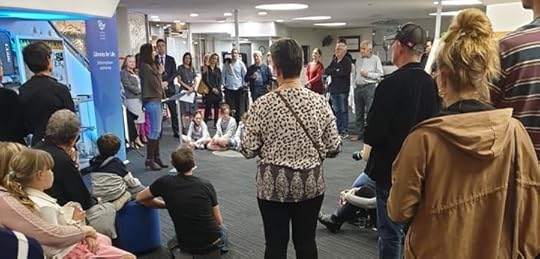 16. Finance
16. FinanceWhen readers borrow books I’ve written from the library, I get a nice annual payment accounting for the lending rights. Fairness!
17. Opportunity
When the Covid-19 pandemic prevented libraries from holding author talks, my local library included me in a showcase of authors at my local theatre to enable social distancing. Innovative!
18. PeopleWhenever I ask a librarian a question, they always help me find answers, until there are no more answers to find. Helpful!
What About You?What memories do you have of libraries and their positive impact on your own and others’ lives?
I bet there are a few!
December 25, 2021
Sunshine Through The Rain #2022

It’s raining today. The forecast over the next few days is also for rain, on and off. There is a single day of ‘sun’. It feels like a metaphor for 2021, searching through time for the brightness among the drab, for the fun among the dreary.

In my first blog post of 2021, ‘Every Step We Take in 2021’, I encouraged readers to use the power of story to rewrite what they wanted to remember of 2020, because memory can be a choice. We can use it to analyse and reframe our futures.
Yet at this stage of the pandemic, I find myself needing a different approach, as I’m not looking to the future much, more to the present. My focus is on day-to-day tasks, what goals at hand I can achieve, next month rather than next year. When it comes to 2022, I’m not really thinking beyond a camping trip with my family and friends in January! Hopefully it won’t rain then!
I’m also looking to the past for inspiration, and am reminded of an approach my father used when he was alive, having survived such significant global events as the Great Depression, WWII and the 1980s worldwide recession. Through each event, he lost everything important to him. Still, when I was growing up, he would often tell me ‘don’t worry about it’ or ‘try not to worry so much’. I don’t believe I did ‘worry’ particularly, but I think it was his way of communicating his state of mind – nothing for him was worth the bother if it came with angst.

Angst can be defined as existentialist dread or anxiety, typically centred on the state of the world or the human condition; though it can also be a simple feeling of anxiety mixed with frustration and negativity. As a writer, I try to ensure my main characters have angst in their lives, because it will drive them to change their lives for the better, and exploring the shenanigans of characters who experience change is one of the reasons we create and share stories.
But I’m not a character in one of my stories and, with so much uncertainty and change happening in the world right now, it feels safer to avoid angst, to take my father’s advice and not worry about anything in particular, and instead live for the moment.
That’s not to say I’m not writing for future publications or planning more opportunities to bring creativity to my community as I have throughout 2021! It just means that my approach to 2022 will be to consciously enjoy whatever single bright days shine through the continual pandemic drab.
Dear reader, will you join me?

Here’s some work I had published in 2021:
Remembering When, Mosman Council
You Pick B, The Ampersand Magazine
The Kind of Man, Welkin Magazine
The Air You Get, Northern Beaches Writers’ Group
The Polite Watchman, SFS Stories
December 1, 2021
Culture Map Live @BeachesCouncil
Visibility is a key component of any business – including cultural and creative ones! So my fabulous local council has created a map of the local area, pinpointing all things creative and cultural on the Northern Beaches: ‘Culture Map Live‘.
I’m thrilled to be included on the map as an author, editor and provider of creative support services, and excited about the map’s potential to generate business – not only in my local area, but for other creatives in other government areas should their councils be inspired to do the same. So please share news of this map far and wide!!
Here’s a little interview I did with the council to generate interest:

And here’s the map itself – have a look and see what creative and cultural services you can find!

Big thanks to my local council for this initiative!

